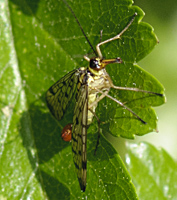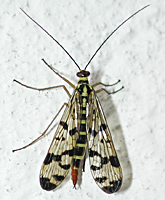[All pictures of garden wildlife on this page are thumbnails. Click on any thumbnail for a large format to be displayed.]

Common Scorpionfly (Panorpa communis)
| Taxonomy | ||||||
|---|---|---|---|---|---|---|
| Kingdom: | Phylum: | Class: | Order: | Family: | Genus: | Species: |
| Animalia | Arthropoda | Insecta | Mecoptera | Panorpidae | Panorpa | P.communis |
Panorpa communis belongs to a small group of insects called scorpionflies. The males have enlarged genitals that look similar to the stinger of a scorpion which explains the name of this group. The females have a shorter and smaller tail than the males. In spite of the reference to dangerous scorpions, there is no need to be afraid of scorpionflies as they do not sting or bite. They feed on rotting fruit and plants mainly and sometimes they suck on dead insects. The name Scorpionflies is a bit misleading because this group of insects has nothing to do with actual flies (Diptera). Real flies have one pair of wings while Scorpion Flies have two.
There are merely a few species belonging to genus Panorpa. In Holland four species are quite common: Panropa cognata, Panorpa vulgaris, Panropa communis and Panorpa germanica. They all look very similar to one another so you must know the specific distinguishing features to pay attention to. It is slightly easier to identify males because their genitals bear small details that differ per species. Females however can not be told apart by inspecting their tale, so we have to look at other features, especially the spots and vain patterns on the wings. Panorpa cognata is the first and easy to identify by its red head while the head is black with all other species. Panorpa germanica can be identified by the absence of the clear black band on the wing and overall less black patterns on the wings.
Panorpa communis and Panorpa vulgaris are most challenging. They both have a clear black band running over the wing therefore an important feature to pay attention to is the tiny basal spot (the first dark spot on the wing, looking from where the wing starts). The spot is usually very small and only slightly larger in Panorpa vulgaris. On Panorpa vulgaris the spot spans over two cells or even spreading beyond, colouring parts of adjacent cells too. Panorpa communis has a smaller spot, sometimes even invisible or absent, which usually marking the area of in one cell only. Sometimes it does run into the second cell, but it never fills it up completely.
I must mention that there are also aberrations in different scorpionflies that make things even more confusing. These variations in features can easily point to the wrong species even for an experienced eye.

© Copyright 1998-2024 gardensafari.net (Hania Berdys)

 English / engels
English / engels  Dutch / nederlands
Dutch / nederlands

